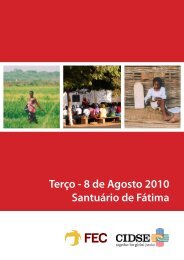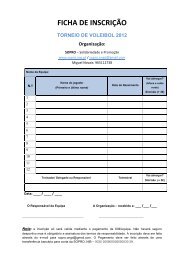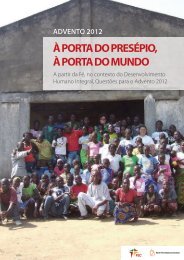Agriculture: from Problem to Solution Achieving the Right ... - Misereor
Agriculture: from Problem to Solution Achieving the Right ... - Misereor
Agriculture: from Problem to Solution Achieving the Right ... - Misereor
You also want an ePaper? Increase the reach of your titles
YUMPU automatically turns print PDFs into web optimized ePapers that Google loves.
4<strong>Agriculture</strong>: <strong>from</strong> <strong>Problem</strong> <strong>to</strong> <strong>Solution</strong> - <strong>Achieving</strong> <strong>the</strong> <strong>Right</strong> <strong>to</strong> Food in a Climate-Constrained WorldDespite his<strong>to</strong>rical overall boosts in production in <strong>the</strong> last 50 years, hunger is increasing.Today we produce 17 percent more calories per day per person than we did 30 years agoin spite of a 70 percent population increase, 10 yet increases in yields have not au<strong>to</strong>maticallytranslated in<strong>to</strong> food security. Hunger is not just a matter of insufficient production, and<strong>the</strong> question of unequal access is crucial as far as food security 11 is concerned.The ‘Price Volatility and Food Security’ Report (2011) 12 by <strong>the</strong> Committee on World FoodSecurity (CFS) High Level Panel of Experts (HLPE) on Food Security and Nutrition statedthat <strong>the</strong>re is “no need <strong>to</strong> boost agricultural growth [but ra<strong>the</strong>r an] urgent need <strong>to</strong> guidethat growth <strong>to</strong>wards long-term food security”. The question is: how can we redirectagriculture <strong>to</strong> serve its social, economic and ecological function in a sustainable way? Forthis <strong>to</strong> happen, we believe <strong>the</strong>re is a need <strong>to</strong> forge sustainable development pathwayswhich will redirect <strong>the</strong> role of agriculture <strong>to</strong> <strong>the</strong> service of society and <strong>to</strong> build diverseand resilient food production systems which contribute <strong>to</strong> food security, social equity andenvironmental regeneration.Finally, <strong>the</strong>re is also an urgent need <strong>to</strong> question our current consumption and productionmodels which are not only unsustainable <strong>from</strong> an agricultural perspective but also amajor driver of climate change. It is imperative <strong>to</strong> put an end <strong>to</strong> highly emitting economiesin general, and <strong>to</strong> place <strong>the</strong> finitude of natural resources at <strong>the</strong> centre of our economicsystem. As such, developed countries must start <strong>to</strong> drastically reduce <strong>the</strong>ir emissions,notably in <strong>the</strong> agricultural sec<strong>to</strong>r, and support developing countries <strong>to</strong> take low emissionsdevelopment pathways.In this light, this paper sets out key recommendations for decision makers, targetingparticularly <strong>the</strong> negotiations on agriculture within <strong>the</strong> Subsidiary Body for Scientific andTechnical Advice (SBSTA) of <strong>the</strong> United Nations Framework Convention on Climate Change(UNFCCC) and <strong>the</strong> round table on food security and climate change at <strong>the</strong> 39 th sessionof <strong>the</strong> Committee on World Food Security (CFS), as <strong>the</strong>se are <strong>the</strong> two most legitimateintergovernmental bodies dealing with climate change and food security respectively.A real change of direction is urgently needed and long overdue. CIDSE calls for <strong>the</strong>following principles, which are presented in detail in this paper, <strong>to</strong> guide future policydirection:• <strong>Right</strong> <strong>to</strong> food approach; removing concepts of charity and emphasising <strong>the</strong> moral andlegal obligation <strong>to</strong> ensure that all people have <strong>the</strong> capacity <strong>to</strong> feed <strong>the</strong>mselves in dignity.• Harnessing agriculture’s role in reducing poverty; as <strong>the</strong> principle economic sec<strong>to</strong>rof most developing countries, agriculture constitutes <strong>the</strong> main source of livelihood for<strong>the</strong> majority of <strong>the</strong> world’s poor. States have an obligation <strong>to</strong> protect and fulfil <strong>the</strong>right <strong>to</strong> adequate food for <strong>the</strong>ir populations, and consequently, <strong>to</strong> support <strong>the</strong>ir localagricultural sec<strong>to</strong>r in a way that responds <strong>to</strong> <strong>the</strong> needs of <strong>the</strong> most vulnerable.
5• Respect for Common but Differentiated Responsibilities (CBDR); a principle whichtranslates <strong>the</strong> joint responsibility of <strong>the</strong> international community for environmentaldamages resulting <strong>from</strong> human activities in a way that reflects countries’ respectivecontributions <strong>to</strong> GHG emissions, <strong>the</strong> way <strong>the</strong>y are impacted by those emissions, and<strong>the</strong>ir respective abilities <strong>to</strong> cope with <strong>the</strong> impacts.• Science integrity and precautionary principle; <strong>the</strong> scientific knowledge provided byintergovernmental scientific bodies on climate change and its environmental and socioeconomicimpacts must be <strong>the</strong> basis of political action.In this paper CIDSE also presents six detailed recommendations <strong>to</strong> policy makers onclimate and agricultural issues.Recommendations:} Invest in small-scale food production} Support sustainable models of production} Beware of false solutions – agriculture in carbon markets and agrofuels 13} Secure access <strong>to</strong> land, natural resources and <strong>the</strong> commons} Align finance, trade and agriculture policies <strong>to</strong> realise <strong>the</strong> right <strong>to</strong> adequate food} Change consumption patterns and reduce food waste and post-harvest loss
7in <strong>the</strong> context of climate change, and <strong>the</strong>importance of <strong>the</strong> participation of thoseaffected in developing and implementingresponses. An approach centred on <strong>the</strong>respect of human rights will also ensure ananalysis that identifies people and groupsthat are particularly vulnerable <strong>to</strong> foodinsecurity and <strong>the</strong> specific barriers <strong>the</strong>yface, including, for example, women.2. Poverty Alleviation and<strong>the</strong> Socio-Economic Roleof <strong>Agriculture</strong>The importance of <strong>the</strong> agricultural sec<strong>to</strong>r <strong>to</strong>poverty alleviation is significant. <strong>Agriculture</strong>represents a larger share of <strong>the</strong> economy inthose countries with <strong>the</strong> highest percentageof poor and undernourished people. As<strong>the</strong> principle economic sec<strong>to</strong>r of mostdeveloping countries, it constitutes <strong>the</strong>main source of livelihood for <strong>the</strong> majorityof <strong>the</strong> world’s poor. The rural poor areparticularly dependent on <strong>the</strong> agriculturalsec<strong>to</strong>r, ei<strong>the</strong>r on a subsistence level or forincome <strong>to</strong> meet household needs.However, <strong>to</strong> encourage growth in thissec<strong>to</strong>r, and <strong>to</strong> face <strong>the</strong> lack of financing by<strong>the</strong> international community, governmentsin developing countries have been turningincreasingly <strong>to</strong> private sec<strong>to</strong>r ac<strong>to</strong>rs and <strong>the</strong>foreign direct investment 17 <strong>the</strong>y provide forsolutions, <strong>the</strong> latter becoming a commonlyaccepted measure of how we define‘success’ in development. There are majorconcerns with such an approach because<strong>the</strong> short-term, profit-seeking objectives ofsome powerful businesses do not address<strong>the</strong> multi-functionality of agriculture,including fac<strong>to</strong>rs such as povertyreduction, environment preservation andterri<strong>to</strong>rial development, amongst o<strong>the</strong>rs.Moreover, standards for transnationalprivate companies’ activities with regards<strong>to</strong> <strong>the</strong>ir impacts on human rights, and<strong>the</strong>ir enforcement, are still very much awork in progress. This is a major issue, asforeign direct investments by transnationalcompanies can lead <strong>to</strong> land and naturalresources’ grabbing, which compromise<strong>the</strong> human rights of local communities.One major risk of this increased rolegiven <strong>to</strong> private sec<strong>to</strong>r ac<strong>to</strong>rs is <strong>the</strong> useof public funds <strong>to</strong> subsidise <strong>the</strong> interestsof certain businesses at <strong>the</strong> expense oflocal populations. Hunger should not beperceived as a business opportunity – <strong>to</strong>take a recent example reported in <strong>the</strong> press,for arbitrage in relation <strong>to</strong> food pricesinduced by <strong>the</strong> 2012 US drought. 18 Hungerand poverty eradication are first andforemost a responsibility of governments<strong>the</strong>mselves. States have an obligation <strong>to</strong>protect and fulfil <strong>the</strong> right <strong>to</strong> adequate foodfor <strong>the</strong>ir populations, and, consequently, <strong>to</strong>Agroecological farming methods include: agroforestry, biological control (controllingpests and diseases with natural preda<strong>to</strong>rs), water harvesting methods, intercropping,green manure cover crops, mixed crop and lives<strong>to</strong>ck management, and many o<strong>the</strong>rpractices. One feature uniting all of <strong>the</strong> above advances is <strong>the</strong> low use of external inputs.To put agroecological technologies in<strong>to</strong> practice requires technological innovations,agriculture policy changes and socio-economic changes, but mostly a deeper understandingof <strong>the</strong> complex long-term interactions among resources, people and <strong>the</strong>ir environment.To attain this understanding, agriculture must be conceived of as an ecological system aswell as a socio-economic system.From: Center for Agroecology and Sustainable Food Systems (UCSC), www.agroecology.org.
9Recommendations forClimate and <strong>Agriculture</strong> policiesThe Committee on World Food SecurityThe Committee on World Food Security (CFS), as <strong>the</strong> foremost inclusive international andintergovernmental platform dealing with food security and nutrition, is <strong>the</strong> legitimatepolicy-making organ which should guide international efforts <strong>to</strong> ensure coherence andavoid fragmentation. Climate and agriculture features high on <strong>the</strong> agenda of <strong>the</strong> 39 thsession of <strong>the</strong> CFS in Oc<strong>to</strong>ber 2012, where a policy roundtable has been devoted <strong>to</strong>discussing <strong>the</strong> issue. We thus urge <strong>the</strong> CFS <strong>to</strong> take in<strong>to</strong> consideration <strong>the</strong> findings of <strong>the</strong>High Level Panel of Experts on Food Security and Nutrition Report on ‘Food security andclimate change’ (2012), in addition <strong>to</strong> our policy recommendations detailed below.The United Nations Framework Convention on Climate ChangeThe consideration of agriculture in <strong>the</strong> United Nations Framework Convention on ClimateChange (UNFCCC) falls under <strong>the</strong> Subsidiary Body for Scientific and TechnologicalAdvice (SBSTA). In its decision 2/CP17, <strong>the</strong> Conference of <strong>the</strong> Parties (COP) decidedin Durban (2011) <strong>to</strong> mandate <strong>the</strong> SBSTA <strong>to</strong> consider issues related <strong>to</strong> agriculture in <strong>the</strong>context of “cooperative sec<strong>to</strong>ral approaches and sec<strong>to</strong>r specific actions, <strong>to</strong> enhance <strong>the</strong>implementation of article 4, paragraph 1(c) of <strong>the</strong> Convention”, 21 with a view <strong>to</strong> a decisionat COP18. The establishment of a work programme on agriculture is one of <strong>the</strong> optionsconsidered in terms of taking <strong>the</strong> issue forward.It is important <strong>to</strong> note that CIDSE rejects any work programme in <strong>the</strong> UNFCCC under <strong>the</strong>Subsidiary Body for Scientific and Technological Advice (SBSTA) which does not address<strong>the</strong> urgent adaptation challenges and <strong>the</strong> need for financial and structural support <strong>to</strong>sustainable farming practices first and foremost. It is crucial that <strong>the</strong> proposal for a workprogramme on agriculture within <strong>the</strong> UNFCCC does not lead <strong>to</strong> mitigation measuresonly, or place additional pressure on small-scale food producers via inadequate climatepolicies. Addressing agriculture in a new dedicated framework may undermine <strong>the</strong> validefforts already being undertaken in regards <strong>to</strong> agriculture adaptation within <strong>the</strong> UNFCCCframework, such as <strong>the</strong> Nairobi work programme and <strong>the</strong> work programme on lossand damage. The interconnection of food production with social, environmental andeconomic issues must be integrated in<strong>to</strong> UNFCCC policies.Based on <strong>the</strong> four principles outlined earlier, CIDSE’s key recommendations <strong>to</strong> guideagriculture and climate policy are as follows:Recommendation 1Invest in small-scale foodproductionInvestment in small-scale food producersvia agroecological approaches can realisemultiple dividends, simultaneouslyincreasing production, food and incomesecurity, enhancing resilience <strong>to</strong> climaterelatedand o<strong>the</strong>r livelihoods shocks, andreducing agriculture’s contribution <strong>to</strong> <strong>the</strong>greenhouse gas emissions. 22To reduce vulnerabilities and increase <strong>the</strong>capacity <strong>to</strong> adapt, power structures thatmade people vulnerable in <strong>the</strong> first placemust be challenged. For example, if <strong>the</strong>problem of food insecurity is caused byfarmers not being able <strong>to</strong> afford farminginputs or having <strong>to</strong>o insecure land tenure<strong>to</strong> have an incentive <strong>to</strong> invest in it, food aidor provision of better climate informationwill do nothing <strong>to</strong> reduce vulnerability.
11<strong>the</strong> delivery of new and additional publicclimate finance.• Fill <strong>the</strong> UNFCCC frameworks, such as <strong>the</strong>Nairobi work programme and <strong>the</strong> workprogramme on loss and damage, withpolitical investment, content and money.To this end, it would be more efficient<strong>to</strong> consolidate <strong>the</strong>se efforts beforedeveloping any new framework thatmight only make <strong>the</strong> negotiations evenmore complex than <strong>the</strong>y already are.• Implement participa<strong>to</strong>ry mechanismsin <strong>the</strong> SBSTA (similar <strong>to</strong> those found in<strong>the</strong> CFS) <strong>to</strong> ensure that <strong>the</strong> needs, viewsand experiences of small-scale foodproducers can be expressed and takenin<strong>to</strong> account.We urge <strong>the</strong> CFS <strong>to</strong>:• Encourage <strong>the</strong> development of local andregional platforms where those mostaffected by food insecurity and climatechange can participate in <strong>the</strong> design,implementation and evaluation ofadaptation and mitigation plans.• Integrate climate change concerns inall of its future work and liaise withand inform UNFCCC discussions onagricultural issues.Recommendation 2Support sustainablemodels of productionThere is a significant distinction between<strong>the</strong> role of different food production modelsand <strong>the</strong>ir contribution <strong>to</strong> GHG emissions,as well as <strong>the</strong>ir added value <strong>to</strong> local foodsystems and potential resilience <strong>to</strong> climatechange. Large-scale industrial agriculture –with high external input use of syn<strong>the</strong>ticnitrogen fertilizers and methane <strong>from</strong> cattleproduction – is highly emitting. Moreover,<strong>the</strong>se production methods contribute <strong>to</strong> <strong>the</strong>reduction of forest cover, and, as a result,<strong>to</strong> emissions <strong>from</strong> deforestation. The CFSHLPE report on ‘Food security and climatechange’ (2012) warns that “significantconversion of new land <strong>to</strong> food productionshould not be a major contribu<strong>to</strong>r <strong>to</strong>increased production because of itsconsequences for GHG emissions.” 25Also, such industrial models are largelycharacterised by monocropping systemswhich are inherently vulnerable <strong>to</strong> climatechange. 26 There is <strong>the</strong>refore a need <strong>to</strong>recognise and acknowledge <strong>the</strong> damagethat has been done by <strong>the</strong>se models ofproduction. Any mitigation policy inagriculture must <strong>the</strong>refore, as a priority,tackle emissions where <strong>the</strong>y are mostimportant, i.e. focusing first and foremos<strong>to</strong>n industrialised agriculture, whilerespecting <strong>the</strong> right <strong>to</strong> development ofsmall producers.The current trend <strong>to</strong> push for ‘sustainableintensification’ via ‘climate-smartagriculture’ 27 should be viewed withcaution. Even though climate change isclearly undermining production capacities,an approach solely based on increasingyields, without questioning <strong>the</strong> model ofproduction itself and its impacts, would bevery limited, particularly as food insecurityis not solely a matter of insufficientproduction but also inadequate access. 28The development of export-drivenindustrial agriculture in some developingcountries is one example of <strong>the</strong> fact thatincreased production does not necessarilylead <strong>to</strong> increased equitable access <strong>to</strong> food.Limited access <strong>to</strong> food, due <strong>to</strong> high foodprices, is one structural root cause offood insecurity. What is needed is ra<strong>the</strong>r<strong>to</strong> support increased productivity andefficiency of small-scale food productionand policies which will ensure food securityat a local level with stable access <strong>to</strong> food. Itmust be noted that beyond <strong>the</strong> productionof commodities, agriculture also has asocial and economic role, whilst providingimportant environmental services whichare public goods. The “multifunctionalnature” 29 of <strong>the</strong> agricultural sec<strong>to</strong>r is largelyneglected in approaches that solely focuson increasing production.The 2008 report by <strong>the</strong> InternationalAssessment of Agricultural Knowledge,Science and Technology for Development(IAASTD) notably reminds us that “smallscalediversified farming is responsiblefor <strong>the</strong> lion’s share of agriculture globally.While productivity increases may beachieved faster in high input, large-scale,specialised farming systems, greatest scopefor improving livelihoods exist in small-
12<strong>Agriculture</strong>: <strong>from</strong> <strong>Problem</strong> <strong>to</strong> <strong>Solution</strong> - <strong>Achieving</strong> <strong>the</strong> <strong>Right</strong> <strong>to</strong> Food in a Climate-Constrained Worldscale, diversified production systems indeveloping countries.” 30Moreover, support for sustainable modelsof production (that is <strong>to</strong> say models whichare based on <strong>the</strong> functioning of ecosystems)implies <strong>the</strong> choice of small-scale and familyfarming over large-scale industrialisedagriculture. Indeed, small-scale farmers arein a better position <strong>to</strong> implement techniquesfor conserving natural resources (such aswater, soil and forests) which respect localconditions, <strong>the</strong>reby creating more resilientand sustainable systems.Food for thought:• Promote policies which will address<strong>the</strong> climate crisis and food insecurity ina holistic way, assessing <strong>the</strong> emissionsrange <strong>from</strong> different agricultural models,as well as <strong>the</strong>ir ability <strong>to</strong> sustainablyreduce emissions. Decisions mustbe based on independent scientificassessments (such as that of <strong>the</strong> IAASTDreport) of <strong>the</strong> emissions <strong>from</strong> differentpractices, and on accurate informationregarding <strong>the</strong> adaptation and mitigationpotentials of each model, including socialaspects and cost effectiveness.• Provide incentives for sustainable foodproduction, agroecology and regenerativeagriculture, as well as promote <strong>the</strong>diversity of <strong>the</strong> genetic resource base.• Take in<strong>to</strong> account <strong>the</strong> primary responsibilityof industrial production models in <strong>the</strong>design of climate mitigation policies.• Fur<strong>the</strong>r clarify <strong>the</strong> concepts of‘sustainable intensification’ and ‘climatesmartagriculture’, taking in<strong>to</strong> account<strong>the</strong>ir impacts on <strong>the</strong> environment andfood security of local communities.We urge parties <strong>to</strong> <strong>the</strong> UNFCCC <strong>to</strong>:• Ensure policies are based on soundscientific research and are governed by<strong>the</strong> precautionary principle. Decisionsunder <strong>the</strong> convention must be informedby relevant international institutions,notably <strong>the</strong> Committee on World FoodSecurity (CFS), and also <strong>the</strong> IAASTDreport and <strong>the</strong> findings <strong>from</strong> <strong>the</strong> UNSpecial Rapporteur on <strong>the</strong> <strong>Right</strong> <strong>to</strong>food 31 on <strong>the</strong> adaptation and mitigationpotentials of agroecological practices.We urge <strong>the</strong> CFS <strong>to</strong>:• Deliver more action-orientated policiesand decisions and promote moni<strong>to</strong>ringand accountability mechanisms for States<strong>to</strong> effectively implement policies andprogrammes.• Assess and compare different farmingsystems and <strong>the</strong>ir contributions <strong>to</strong>emissions (direct and indirect) andpotential for adaptation.• Call for increased investments andresearch in<strong>to</strong> agroecological models<strong>to</strong> ensure food security and increaseresilience with special attention <strong>to</strong> <strong>the</strong>needs of women farmers.• Encourage States <strong>to</strong> remove incentivesfor emission-intensive agriculture.Recommendation 3Beware of false solutions– agriculture in carbonmarkets and agrofuelsThough low-emitting food productionsystems are crucial for reducing <strong>the</strong>contribution of agriculture <strong>to</strong> overallGHG emissions, such systems need <strong>to</strong> besupported in a way that is coherent andaddresses agriculture adaptation as apriority. For instance, many false solutions<strong>to</strong> climate change mitigation in <strong>the</strong>agricultural sec<strong>to</strong>r are being promoted.Essentially, <strong>the</strong>se ‘solutions’ are inadequatefor both climate mitigation and foodsecurity. The inclusion of agriculture incarbon markets is one example of a falsesolution. It is argued that this solutionwould be a good way <strong>to</strong> mobilise financialresources <strong>to</strong> ensure climate mitigationin agriculture whilst fostering adaptationand alleviating poverty. Proposals <strong>to</strong>include agriculture in offsetting marketsare, however, questionable <strong>from</strong> anenvironmental perspective and presentconsiderable risks for small-scale producers.There are indeed major concerns that soilcarbon markets lead <strong>to</strong> increased pressureon food security, whilst at <strong>the</strong> sametime contributing nothing <strong>to</strong> emissionsreductions and also undermining climatemitigation efforts. Firstly, large farms andagribusiness, ra<strong>the</strong>r than small-scale farms,would be likely <strong>to</strong> attract most investmentin soil carbon sequestration. Under <strong>the</strong>
13Clean Development Mechanism (CDM) andany regulated carbon offset mechanism,project development and certificationcycles are lengthy, complex and costly.Consequently, those most likely <strong>to</strong> obtaincarbon credits are those who can afford <strong>to</strong>pay for specialist ‘carbon consultants’ andwho can offer offset projects large enough<strong>to</strong> cover <strong>the</strong> CDM-related transaction costs.Moreover, <strong>the</strong>re is a fear that such a solutionmay undermine climate change mitigation.Carbon offset strategies such as <strong>the</strong> CDMare only feasible for industrial processes,where greenhouse gas emissions caneasily be measured. Agricultural fields,however, are subject <strong>to</strong> complex biologicalprocesses and are highly heterogeneous innature. This makes it difficult <strong>to</strong> obtain <strong>the</strong>reliable soil carbon measurements whichwould be essential for <strong>the</strong> quantificationof sequestered CO 2 and <strong>the</strong> generation ofcorresponding credits.Finally, including agriculture in carbonmarkets could also lead <strong>to</strong> increasedpressure on land as inves<strong>to</strong>rs becomeattracted <strong>to</strong> <strong>the</strong> financial gains associatedwith acquiring land under this scenario.This can fur<strong>the</strong>r incentivise land grabbing,leading <strong>to</strong> continued expansion of large-scalemonocultures at <strong>the</strong> expense of smallholders,traditional crops and biodiversity.Ano<strong>the</strong>r false solution of grave concernis <strong>the</strong> use of agrofuels as substitutes forconventional oil, which is currently beingpromoted <strong>to</strong> de-carbonise <strong>the</strong> transportsec<strong>to</strong>r. This has led <strong>to</strong> major social andenvironmental impacts, most notably onagriculture and food security, with onlymarginal or even negative impacts onclimate mitigation. The growing demandfor agrofuels has had negative effects onlocal food security due <strong>to</strong> pressures onland and competition between food andfuel crops. Agrofuel policies have alsoled <strong>to</strong> <strong>the</strong> indexing of food prices <strong>to</strong> oilprices, contributing <strong>to</strong> increased food pricevolatility. The contribution <strong>to</strong> GHG emissionsof <strong>the</strong> Indirect Land Use Change (ILUC)for agrofuels production (via deforestationand conversion of land for fuel crops, forexample), is very significant, and stronglyundermines agrofuel mitigation potentials. 32As such, <strong>the</strong>re is little evidence that<strong>the</strong> majority of agrofuel policies andprogrammes are aiding ei<strong>the</strong>r climatechange mitigation or food security. 33Hence, mitigation policies need <strong>to</strong> integrateassessments of <strong>the</strong> potential detrimentalimpact that could undermine foodproduction or encourage land grabbing, soas not <strong>to</strong> fur<strong>the</strong>r incentivise false solutions.Food for thought:• Reject <strong>the</strong> use of flexibility mechanismsthat shift responsibility for mitigation <strong>to</strong>developing countries.• Ensure that potential solutions are indeedaccessible <strong>to</strong> small-scale food producersand will not create more of a burden,such as increased debt.• Abolish agrofuel blending mandatesand any subsidies for production (suchas public investment or fiscal facilities)and focus on ways <strong>to</strong> reduce energyconsumption, ra<strong>the</strong>r than maintaining<strong>the</strong>m at <strong>the</strong> current unsustainable level.• Establish strong social and environmentalsafeguards <strong>to</strong> govern private investmentsin agricultural adaptation and mitigationprojects.We urge parties <strong>to</strong> <strong>the</strong> UNFCCC <strong>to</strong>:• Consider adaptation as <strong>the</strong> priority focusof climate policy dealing with agriculture.Mitigation options considered shouldaim at reducing emissions where <strong>the</strong>y aremost important, i.e. industrial agriculturefirst and foremost.• Thoroughly assess mitigation optionsconsidered by all parties, and aim atbeing sustainable, equitable and fair. Thepotential impacts of mitigation optionson food security must be assessed andsubsequently addressed.• Reject <strong>the</strong> inclusion of agriculture incarbon markets. Proposals for mitigationmeasures must include indica<strong>to</strong>rs<strong>to</strong> effectively moni<strong>to</strong>r <strong>the</strong> emissionsreductions, <strong>the</strong> effectiveness and <strong>the</strong>sustainability of different approaches.• Consider <strong>the</strong> work undertaken by <strong>the</strong>Intergovernmental Panel on ClimateChange (IPCC) <strong>to</strong>wards <strong>the</strong> fifthassessment report (AR5), providing areview of climate science as <strong>the</strong> guidelineof political decision on climate and a <strong>to</strong>ol<strong>to</strong> revise countries’ pledges.
14<strong>Agriculture</strong>: <strong>from</strong> <strong>Problem</strong> <strong>to</strong> <strong>Solution</strong> - <strong>Achieving</strong> <strong>the</strong> <strong>Right</strong> <strong>to</strong> Food in a Climate-Constrained World• Integrate an approach <strong>to</strong> agriculture in<strong>the</strong> UNFCCC throughout global, nationaland local levels. The SBSTA shouldprovide information <strong>to</strong> parties on howconsistency can be guaranteed betweenactions planned in National AdaptationProgramme of Actions (NAPAs) andNationally Appropriate MitigationActions (NAMAs) and policy proposalson agriculture.We urge <strong>the</strong> CFS <strong>to</strong>:• Ensure that adaptation and mitigationprogrammes, policies and strategies areassessed, ex-ante and ex-post for <strong>the</strong>irpossible impacts on <strong>the</strong> right <strong>to</strong> adequatefood.• Encourage governments and donors<strong>to</strong> support <strong>the</strong> development anddissemination of projects that streng<strong>the</strong>nadaptation with sustainable practicesincreasing carbon sequestration andintegrating disaster risk reduction whereappropriate.• Challenge false solutions, such asagrofuels, by exposing <strong>the</strong> impacts ofsuch policies on food security.• Strongly reject <strong>the</strong> promotion ofgenetically modified seeds in <strong>the</strong> nameof resistance <strong>to</strong> climate stresses such asdrought or salinity in any climate-relatedpolicy. Patenting of all forms of lifeshould be strictly banned.Recommendation 4Secure access <strong>to</strong> land,natural resources and <strong>the</strong>commonsLack of secure land tenure and access <strong>to</strong>natural resources is one of <strong>the</strong> key structuralcauses of hunger and poverty. Access andconflict over productive resources suchas arable land and water will becomeincreasingly strained due <strong>to</strong> climate change.It is <strong>the</strong>refore imperative that governmentsprotect <strong>the</strong> rights of small-scale foodproducers <strong>to</strong> <strong>the</strong>ir resources as <strong>the</strong>y are <strong>the</strong>primary stewards of such resources.Arable land, or <strong>the</strong> proportion of <strong>the</strong> earthwhere food can grow, is being depletedat an alarming rate. Today, less than tenpercent of <strong>the</strong> planet’s <strong>to</strong>tal land area isarable. During <strong>the</strong> past 40 years nearly onethird of <strong>the</strong> world’s cropland (1.5 billionhectares) has been abandoned because ofsoil erosion and degradation. This meanswe are losing about 75 million hectares <strong>to</strong>land degradation every year. 34 Economicinterests are becoming increasinglydirected <strong>to</strong>wards this most scarce resourceand this is leading <strong>to</strong> <strong>the</strong> dispossession ofthousands of people <strong>the</strong> world over. Thistrend, also known as ‘land grabbing’, islikely <strong>to</strong> continue unless measures are putin place <strong>to</strong> protect <strong>the</strong> poorest.Land grabbing can lead <strong>to</strong> <strong>the</strong> dispossessionand/or <strong>the</strong> adverse incorporation of peoplein<strong>to</strong> an unsustainable agro-industrialsystem. It compromises <strong>the</strong>ir livelihoodsand <strong>the</strong>ir capacities <strong>to</strong> feed <strong>the</strong>mselves andfur<strong>the</strong>r intensifies resource degradation.Drivers of land grabbing include foodproduction for wealthier countries, agrofuelproduction, large-scale infrastructureprojects, carbon credit and o<strong>the</strong>r marketbasedmechanisms, as well as purespeculation on this increasingly scarceresource by banks, pension funds ando<strong>the</strong>r financial ac<strong>to</strong>rs. Rising agriculturalcommodity prices make <strong>the</strong> acquisitionof land look like an increasingly attractiveinvestment option.Efforts must be stepped up <strong>to</strong> secure landfor small-scale producers. This will ensurepeople are not arbitrarily dispossessed of<strong>the</strong>ir land, and obtain better deals <strong>from</strong>incoming inves<strong>to</strong>rs.There is also a need <strong>to</strong> institute redistributiveland reform <strong>to</strong> address <strong>the</strong> unequaldistribution of land which characterises<strong>the</strong> post-colonial context of so many of <strong>the</strong>world’s poorest people.
15Food for thought:• Secure land tenure and rights of usersthrough <strong>the</strong> rapid implementation of <strong>the</strong>‘Voluntary Guidelines for <strong>the</strong> ResponsibleGovernance of Land, Fisheries andForests.’ 35• Introduce a two-year mora<strong>to</strong>rium on largescaleland investments made by foreignand transnational companies, until <strong>the</strong>final conclusion and implementationof <strong>the</strong> CFS principles on ResponsibleAgricultural Investment (RAI).• Recognise cus<strong>to</strong>mary rights.• Provide land redistribution andcompensation where necessary.• Integrate <strong>the</strong> principle of free, priorand informed consent and robustcompensation regimes in<strong>to</strong> nationallegislation through appropriate legalframeworks which ensure legal supportfor local populations, as well as protectionof those defending land rights.• Integrate <strong>the</strong> nexus of sustainablemodels (such as agroecology) in<strong>to</strong>discussions regarding <strong>the</strong> CFS principleson Responsible Agricultural Investment.We urge parties <strong>to</strong> <strong>the</strong> UNFCCC <strong>to</strong>:• Fur<strong>the</strong>r work on <strong>the</strong> interactions betweenclimate change and land grabbing, soas <strong>to</strong> ensure that mitigation and energypolicies do not fur<strong>the</strong>r contribute <strong>to</strong> thisphenomenon. Policies such as agrofueltargets and subsidies, which divertfood <strong>to</strong> energy use and promote landconcentration, must be abolished.We urge <strong>the</strong> CFS <strong>to</strong>:• Support <strong>the</strong> implementation of <strong>the</strong>Voluntary Guidelines for <strong>the</strong> ResponsibleGovernance of Tenure of Land, Fisheriesand Forests as its foremost priority.• Support <strong>the</strong> development of integratedland use policies for food security,adaptation and mitigation.• Reduce land use change for agriculturethrough support for agroforestry forinstance.Recommendation 5Align finance, tradeand agriculture policies<strong>to</strong> realise <strong>the</strong> right <strong>to</strong>adequate foodIt is anticipated that climate change willhave dire impacts on food production, and,as a result, on food prices. His<strong>to</strong>rically,<strong>the</strong> availability of cheap food on <strong>the</strong>international market was one of <strong>the</strong> fac<strong>to</strong>rsthat contributed <strong>to</strong> reduced investment andsupport <strong>to</strong> local agriculture in developingcountries. This is generally put forward asone of <strong>the</strong> reasons for <strong>the</strong> food crisis of2007–2008, as countries found <strong>the</strong>mselvesvulnerable <strong>to</strong> price fluctuations and unable<strong>to</strong> procure locally for <strong>the</strong>ir needs. Fordeveloping countries, market liberalisationhas meant a significant increase independence on food imports, making <strong>the</strong>rise in prices a matter of grave concern.Trade policies were negotiated in an eraof overproduction and this now needs <strong>to</strong>be revisited. One of <strong>the</strong> main lessons <strong>to</strong>be learned <strong>from</strong> <strong>the</strong> food crisis is that <strong>the</strong>world market is not a reliable source forstable and affordable food supply any more.In times of increased prices and volatility,imports cannot be <strong>the</strong> corners<strong>to</strong>ne of anysustainable food security strategy. 36In a 2011 discussion paper <strong>from</strong> UNCTAD, 37a “significant shift <strong>from</strong> conventional,industrial, monoculture-based and highexternal input-dependent production<strong>to</strong>wards sustainable production systemsthat considerably improve <strong>the</strong> productivityof small-scale food producers” wasrecommended. Increasing food productionin this way needs <strong>to</strong> be accompanied by amore supportive trade and macroeconomicframework if improved livelihoods andhigher incomes for small-scale foodproducers are <strong>to</strong> be realised.Despite this fact, food trade is expected<strong>to</strong> increase under climate change, withmost developing countries becomingmore dependent on food imports andfluctuations in market prices and thusincreasing vulnerability <strong>to</strong> related shocks.
16<strong>Agriculture</strong>: <strong>from</strong> <strong>Problem</strong> <strong>to</strong> <strong>Solution</strong> - <strong>Achieving</strong> <strong>the</strong> <strong>Right</strong> <strong>to</strong> Food in a Climate-Constrained WorldFood for thought:• Better incorporate food security andclimate change concerns in<strong>to</strong> marketpolicies and trade agreements duringinternational negotiations.• Revaluate trade rules <strong>to</strong> reflect concernsabout <strong>the</strong> right <strong>to</strong> adequate foodra<strong>the</strong>r than prioritising <strong>the</strong> concerns ofexporters <strong>to</strong> access markets.• Create space in trade negotiations forfood-insecure countries <strong>to</strong> respond <strong>to</strong>international price fluctuations, including<strong>the</strong> implementation of price stabilisationmeasures, import quotas and tariffs andeven export restrictions if needed.• Grant low-income, food-deficientcountries special consideration whennegotiating trade rules.• Make multilateral, bilateral and nationalagricultural trade policies subject <strong>to</strong> exanteand ex-post socio-economic andenvironmental impact assessments.• Enable governments in developingcountries <strong>to</strong> move ahead with effectivetrade measures, including use of specialsafeguards in order <strong>to</strong> support smallscalefood producers’ participation inlocal and regional markets.• Implement new and innovative financialsystems as promising sources of publicclimate finance, such as a FinancialTransaction Tax (FTT), in order <strong>to</strong> supportadaptation and mitigation initiatives.• Introduce tighter rules on speculationin financial markets, including <strong>the</strong>establishment of position limits for ‘nonbonafide’ac<strong>to</strong>rs.We urge <strong>the</strong> CFS <strong>to</strong>:• Fur<strong>the</strong>r elaborate discussions on <strong>the</strong> roleof trade on food security, paying specialattention <strong>to</strong> <strong>the</strong> new challenges posed byclimate change.Recommendation 6Change consumptionpatterns and reduce foodwaste and post-harvestlossToday, while nearly one billion peopleexperience hunger, ano<strong>the</strong>r one billion areconsidered obese and overweight. 38 Obesitycauses 3.8 million deaths worldwide before<strong>the</strong> age of sixty, 39 and in <strong>the</strong> coming years,<strong>the</strong> number of deaths <strong>from</strong> obesity-relatedconditions is expected <strong>to</strong> climb <strong>to</strong> 5.1million by 2030. In countries such as <strong>the</strong>United States, this means that <strong>the</strong> currentgeneration of children could have shorterlife expectancies than <strong>the</strong>ir parents due <strong>to</strong><strong>the</strong>ir dietary lifestyles. 40As a planet, we are consuming more food,due in part <strong>to</strong> population growth, butalso because average food consumptionis increasing. In particular, those who canafford it are eating higher proportions ofmeat, dairy products and processed foodswhich are less efficient at being converted<strong>to</strong> calories than whole grains, fruits andvegetables. Ironically, economic growth iscontributing <strong>to</strong> this change. Nutrition isimproving in India, China and elsewhere,but a growing part of <strong>the</strong>se populationsare also over-consuming and consumingmore processed foods, leading <strong>to</strong> a dietarytransition which is having serious impactson public health. Obesity is also related <strong>to</strong><strong>the</strong> quality of <strong>the</strong> food being consumed.To support this dietary transition, we arewitnessing an increased diversion of graincrops <strong>from</strong> human food <strong>to</strong> animal feed, asdemand for meat and dairy products hassteadily risen since <strong>the</strong> 1960s. 41 About onethird of world crop production (covering 3.7billion hectares) is used <strong>to</strong> feed animals. 42On average, it takes around 6kg ofplant protein <strong>to</strong> produce just 1kg ofanimal protein. 43 Land needed by local/indigenous populations for <strong>the</strong>ir ownfood production is being taken over <strong>to</strong>raise animal feed. The division betweenfeed cultivation and lives<strong>to</strong>ck productionis also a growing problem. A fundamentalaspect of sustainable agricultural systemsis that nutrients are circulated; for instance,manure <strong>from</strong> lives<strong>to</strong>ck is used <strong>to</strong> fertilize<strong>the</strong> fields. When animal productionand feed cultivation are geographicallyseparated, nutrients cannot be recycled andare <strong>the</strong>refore lost in <strong>the</strong> local nutrient cycle.Fur<strong>the</strong>rmore, more than one third of <strong>the</strong>food produced on this planet for humanconsumption is wasted. 44 This amounts <strong>to</strong>approximately 1.3 billion <strong>to</strong>nnes of lost food
17per year. 45 In developing countries, wasteoccurs mainly on-farm, due <strong>to</strong> limitationsin post-harvest methods, preservationtechniques, packaging and distributionsystems. In developed countries, wastemost often results <strong>from</strong> consumerbehaviour and inefficient processes in <strong>the</strong>supply chain. This presents a tremendousopportunity when we consider that all of<strong>the</strong> hungry people in <strong>the</strong> world could belifted out of undernourishment on lessthan 25 percent of <strong>the</strong> food that is wastedin <strong>the</strong> United States and Europe alone. 46According <strong>to</strong> <strong>the</strong> FAO, ten percent of richcountries’ greenhouse gas emissions come<strong>from</strong> growing food that is never eaten.In a world challenged by climate change,a rising population, and a global economiccrisis, we need <strong>to</strong> be smarter, more efficient,and fairer about <strong>the</strong> way we produce,distribute and consume our food. Largecorporations are taking over more andmore of <strong>the</strong> food system, using productionmethods that deplete resources in <strong>the</strong> longterm.Food and land are seen as tradablecommodities, with <strong>the</strong>ir value set byinves<strong>to</strong>rs interested in profit. The foodindustry inflicts more than two dollars ofenvironmental and resource damage forevery one dollar of profit. On net sales ofUS$12.8 trillion, it causes US$200 billionworth of environmental problems, which is224 percent more than its profit earnings. 47In sum, current production techniquesoffer minimal gains while <strong>the</strong> human andenvironmental costs are severe. These aresystemic problems in how we produce,distribute and consume food, and problemswhich need <strong>to</strong> be challenged.Food for thought:• Invest in consumer awareness andencourage a shift <strong>to</strong>wards healthierand more sustainable dietary choicesas part of adaptation. This includesmore consumption of diverse fruit andvegetables and less consumption oflives<strong>to</strong>ck products.• Invest in consumer awareness on <strong>the</strong> foodwaste issue, particularly in developedcountries.• Introduce mechanisms and innovationsthat will produce more efficient foodsystems with less waste along <strong>the</strong> chain,including <strong>the</strong> re-use of urban organicwaste (free <strong>from</strong> pollutants) backin<strong>to</strong> agricultural land, as well as <strong>the</strong>reutilisation of animal manure for biogas,for instance.• Identify and support food productionprocesses and distribution practiceswhich are more resource efficient andhave fewer environmental externalities,encouraging and enforcing restrictionson <strong>the</strong> private sec<strong>to</strong>r <strong>to</strong> produce anddistribute in ways that result in fewerGHG emissions.• Establish shorter food chains and localeconomies through farmers’ markets,community-supported agriculture andlocal food councils, for example.• Support better post-harvest measuresin developing countries where food iswasted on farm.• Streng<strong>the</strong>n consumer organisations.• Procure locally for social programmeswhen possible.We urge parties <strong>to</strong> <strong>the</strong> UNFCCC <strong>to</strong>:• Provide parties, via <strong>the</strong> SBSTA, withinformation on <strong>the</strong> mitigation potentialof measures limiting <strong>the</strong> expansion of<strong>the</strong> wasteful agri-food chain, and offersupport <strong>to</strong> more efficient post-harvestmeasures in developing countries.
18<strong>Agriculture</strong>: <strong>from</strong> <strong>Problem</strong> <strong>to</strong> <strong>Solution</strong> - <strong>Achieving</strong> <strong>the</strong> <strong>Right</strong> <strong>to</strong> Food in a Climate-Constrained WorldConclusionUnder <strong>the</strong> ‘business as usual’ scenario,increases in agricultural productionwill fundamentally mean increases ingreenhouse gas emissions; but <strong>the</strong>re areways, via agroecological models, <strong>to</strong> delinkfood production <strong>from</strong> increased emissions.Building resilience in production systemsand <strong>the</strong> livelihood strategies of <strong>the</strong> pooris essential if communities are <strong>to</strong> adapt<strong>to</strong> both climatic and economic changes.To this end, <strong>the</strong>re is a need <strong>to</strong> curb <strong>the</strong>expansion of <strong>the</strong> industrial agri-foodmodel and support agroecological modelsof production which are accessible <strong>to</strong>small-scale food producers, support <strong>the</strong>regenerative capacities of <strong>the</strong> earth and donot contribute <strong>to</strong> fur<strong>the</strong>r GHG emissions.A shift in <strong>the</strong> way we conceive and practiceagriculture is urgently needed. Part andparcel of this is <strong>the</strong> recognition of <strong>the</strong> role ofinclusive governance in ensuring all partiesuphold a vision for sustainable agriculture.Public consultations and participation inadaptation and mitigation programmes andprojects, as well as open, transparent, andinclusive decision making are critical if weare <strong>to</strong> realise <strong>the</strong> right <strong>to</strong> adequate food ina climate-constrained world.The fragmentation of policies by sec<strong>to</strong>rcannot respond <strong>to</strong> <strong>the</strong> new challengesposed by climate change. Coherent policies,grounded in human rights, must be <strong>the</strong>corners<strong>to</strong>ne for all decision making.
19Agroecology in PracticeAS-PTA (Agroecology and Family Farming) has worked with small farmers’ communitiessince 1983, promoting agroecology as a strategy <strong>to</strong> overcome food insecurity and poverty. Inits local development programme in <strong>the</strong> semi-arid region of <strong>the</strong> Brazilian Nor<strong>the</strong>ast, AS-PTAcooperate with regional farmers’ organisations, involving up <strong>to</strong> 14 municipal level unionsand hundreds of community-level associations in one of <strong>the</strong> largest NGO-led initiatives inBrazil. Through participa<strong>to</strong>ry methods, <strong>the</strong> organisation has identified <strong>the</strong> main productionand marketing constraints faced by <strong>the</strong>se communities, analysing <strong>the</strong>ir root causes andproposing and piloting solutions.One of <strong>the</strong> most important issues in this region is water scarcity for human and animalconsumption, as well as agricultural production. The potential of rain water harvesting,including innovative techniques such as subterranean dams and micro-irrigation projects,has been identified as an important response <strong>to</strong> <strong>the</strong> dry spells that frequently affect <strong>the</strong>region. The propagation of local seed varieties which are more resilient <strong>to</strong> drought, as wellas natural vegetation management for animal rearing, are also important complementarystrategies.Evaluations of AS-PTA’s projects have demonstrated improved income generation throughimproved production and better access <strong>to</strong> local markets, as well as significant increases in<strong>the</strong> nutritional well-being of households involved. Most importantly, AS-PTA has seen thatparticipants in <strong>the</strong> programme have become much less vulnerable <strong>to</strong> drought conditionssince <strong>the</strong>y began implementing agroecological methods.AS-PTA is part of a national network for agroecological development and disseminates itsmethods and techniques <strong>to</strong> o<strong>the</strong>r civil society partners. This network (ANA) also advocatesat <strong>the</strong> local and national levels for public policies which promote rural sustainabledevelopment and improve conditions for <strong>the</strong> family farmers who are responsible for 70percent of <strong>the</strong> production of <strong>the</strong> food consumed in Brazil.www.aspta.org.br
20<strong>Agriculture</strong>: <strong>from</strong> <strong>Problem</strong> <strong>to</strong> <strong>Solution</strong> - <strong>Achieving</strong> <strong>the</strong> <strong>Right</strong> <strong>to</strong> Food in a Climate-Constrained WorldReferences1 According <strong>to</strong> <strong>the</strong> Committee on World Food Security High Level Panel of Experts on Food Securityand Nutrition Report on Food Security and Climate Change, crop and lives<strong>to</strong>ck agriculture accountedfor 15 percent of emissions in 2005. This includes two percent <strong>from</strong> related sec<strong>to</strong>rs (production ofchemical inputs, energy consumptions, irrigation, etc.). Land use change in and of itself accounts forano<strong>the</strong>r 11–17 percent. See: www.fao.org/cfs.2 Institute for <strong>Agriculture</strong> and Trade Policy, <strong>Agriculture</strong> in <strong>the</strong> climate talks: looking beyondCancun, 2010, p.2, www.iatp.org.3 For <strong>the</strong> purposes of this paper ‘small-scale food producers’ refers <strong>to</strong> all those engaged inlivelihoods related <strong>to</strong> food production – this includes, farmers, fisherfolks, pas<strong>to</strong>ralists, ga<strong>the</strong>rers/harvesters and agricultural workers. The concept of ‘small scale’ differs significantly betweencountries and is not merely a matter of hectares. For <strong>the</strong> sake of this paper, we use <strong>the</strong> term <strong>to</strong>capture <strong>the</strong> concept of scale in <strong>the</strong> operation, as well as <strong>the</strong> model of production it employs and<strong>the</strong> contribution of family labour <strong>to</strong>wards <strong>the</strong> production.4 In Africa and Latin America, small-scale farming represents approximately 80 percent of all farms.In Latin America small-scale farms produce up <strong>to</strong> 67 percent of <strong>to</strong>tal output and create up <strong>to</strong>77 percent of employment in <strong>the</strong> agricultural sec<strong>to</strong>r (FAO, 2001).5 PBL Ne<strong>the</strong>rlands Environmental Assessment Agency and European Commission Joint ResearchCenter, Trends in Global CO 2 Emissions, 2012, p.6.6 The 2° <strong>to</strong> 1.5°C threshold of temperature rise has been long identified as <strong>the</strong> ceiling above whichclimate change would become irreversible, calling for ambitious and urgent political action.7 UNEP, Bridging <strong>the</strong> Emissions Gap, 2011, p.8, www.unep.org.8 The Consultative Group on International Agricultural Research (CGIAR), <strong>Agriculture</strong> and RuralDevelopment Day 2012: Lessons in Sustainable Landscapes and Livelihoods, www.cgiar.org/press-releases.9 Foresight, The Future of Food and Farming, 2011, p.134, www.bis.gov.uk.10 FAO, IFAD, WFP, Reducing Poverty And Hunger: The Critical Role Of Financing For Food,<strong>Agriculture</strong> And Rural Development, 2002, p.9, www.fao.org.11 There are four pillars <strong>to</strong> food security: availability, access, utilisation and stability.12 The Committee on World Food Security High Level Panel of Experts on Food Security andNutrition, Report on Price Volatility and Food Security, 2011, www.fao.org/cfs.13 CIDSE opts <strong>to</strong> use <strong>the</strong> term ‘agrofuels’, as opposed <strong>to</strong> ‘biofuels’. ‘Agrofuels’ are liquid fuels made<strong>from</strong> fuel crops grown on a large scale for agro-industrial models. Agrofuels, such as ethanoland bio-diesel, are currently produced <strong>from</strong> plants such as corn, oil palm, soy, sugar cane, sugarbeet, rapeseed, canola, jatropha, rice and wheat. ‘Biofuels’, on <strong>the</strong> o<strong>the</strong>r hand, refer <strong>to</strong> small-scalemodels of production, and <strong>to</strong> non-industrial liquid fuels frequently made in owner-operatedfacilities for local consumption. See: Food First, Agrofuels in <strong>the</strong> Americas, Chapter II, p.4, 2009,www.foodfirst.org.)14 United Nations, The Universal Declaration of Human <strong>Right</strong>s, www.un.org.15 Office of <strong>the</strong> United Nations Commissioner for Human <strong>Right</strong>s, International Covenant onEconomic, Social and Cultural <strong>Right</strong>s, www2.ohchr.org.16 Olivier De Schutter, www.srfood.org.17 For more information on how agricultural investment by private sec<strong>to</strong>r and agribusinessac<strong>to</strong>rs impacts <strong>the</strong> global South, see: Entraide et Fraternité, Commerce international, 2012,www.entraide.be.
2118 Reuters, Glencore sees opportunities in US drought, 21 August 2012, www.reuters.com.19 Article 3.1 of <strong>the</strong> United Nations Framework Convention On Climate Change statesthat “parties should protect <strong>the</strong> climate system for <strong>the</strong> benefit of future and presentgenerations of human kind on <strong>the</strong> basis of equity and in accordance with <strong>the</strong>ir commonbut differentiated responsibility and respective capabilities. Accordingly, developedcountries should take <strong>the</strong> lead in combating climate change and <strong>the</strong> adverse effects<strong>the</strong>reof”. United Nations, UN Framework Convention on Climate Change (UNFCCC),1992, p5, www.unfccc.int.20 United Nations Framework Convention on Climate Change (UNFCCC), Article 3.3, 1992,p.6, www.unfccc.int.21 ‘All Parties, taking in<strong>to</strong> account <strong>the</strong>ir common but differentiated responsibilities and<strong>the</strong>ir specific national and regional development priorities, objectives and circumstances,shall: (c) Promote and cooperate in <strong>the</strong> development, application and diffusion, includingtransfer, of technologies, practices and processes that control, reduce or preventanthropogenic emissions of greenhouse gases not controlled by <strong>the</strong> Montreal Pro<strong>to</strong>colin all relevant sec<strong>to</strong>rs, including <strong>the</strong> energy, transport, industry, agriculture, forestry andwaste management sec<strong>to</strong>rs.’ See: United Nations Framework Convention On ClimateChange (UNFCCC), Article 4c, 1992, p.6, www.unfccc.int.22 For more information, including specific case studies, on how small-scale agriculturecan contribute simultaneously <strong>to</strong> climate change mitigation, adaptation and povertyreduction, see: Trócaire, Policy Report: Climate Change, Climate Action, Climate Justice,2011, www.trocaire.org.23 A 2010 World Bank report estimated that for <strong>the</strong> period between 2010 and 2050, <strong>the</strong>costs of adapting <strong>to</strong> a 2°C warmer world will be in <strong>the</strong> range of $70 billion <strong>to</strong> $100billion per year. See: World Bank, Economics of Adaptation <strong>to</strong> Climate Change, Syn<strong>the</strong>sisReport, 2010, p.XV–XVI, www.climatechange.worldbank.org.24 FAO, Towards sustainable food security: Women and sustainable food security, www.fao.org.25 The Committee on World Food Security High Level Panel of Experts on Food Securityand Nutrition, Report on Food Security and Climate Change, 2012, p.54, www.fao.org/cfs.26 Resilience <strong>to</strong> climate disasters is closely linked <strong>to</strong> <strong>the</strong> level of on-farm biodiversity. See:Altieri MA, The scaling up of agroecology: spreading <strong>the</strong> hope for food sovereignty andresilience, 2012, www.agroeco.org.27 More information and specific examples of agricultural approaches being referred <strong>to</strong>by some as ‘climate smart’ are available in a series of Policy Briefings by <strong>Misereor</strong>. See:www.misereor.org/publications/climate-change-and-justice.28 FAO, An Introduction <strong>to</strong> <strong>the</strong> Basic Concepts of Food Security, 2008, www.fao.org.29 International Assessment of Agricultural Knowledge, Science and Technology forDevelopment (IAASTD), <strong>Agriculture</strong> at a Crossroads, 2008, p.3, www.agassessment.org.30 International Assessment of Agricultural Knowledge, Science and Technology forDevelopment (IAASTD), <strong>Agriculture</strong> at a Crossroads, 2008, p.379, www.agassessment.org.31 Olivier de Schutter, Agroecology and <strong>the</strong> <strong>Right</strong> <strong>to</strong> Food, 2011, www.srfood.org.32 International Food Policy Research Institute (IFPRI), ‘Assessing <strong>the</strong> Land Use ChangeConsequences of European Biofuel Policies’, http://ec.europa.eu/trade.33 The Committee on World Food Security (CFS) High Level Panel of Experts, Food securityand Climate Change, 2012, p.78, www.fao.org/cfs.
22Food Price Volatility - Consequences and impacts on <strong>the</strong> <strong>Right</strong> <strong>to</strong> Food34 It takes approximately 500 years <strong>to</strong> replace 25 millimetres of <strong>to</strong>psoil and <strong>the</strong> minimal soil depthfor agricultural production is 150 millimeters. See: David Pimental, Soil as an EndangeredEcosystem, Bioscience, 2000, www.bioone.org.35 FAO, CFS, Voluntary Guidelines on <strong>the</strong> Responsible Governance of Tenure of Land, Fisheriesand Forests, 2012, www.fao.org.36 CIDSE, Food Price Volatility – Consequences and impacts on <strong>the</strong> <strong>Right</strong> <strong>to</strong> Food, 2011,www.cidse.org/resources.37 UNCTAD, Assuring Food Security in Developing Countries under <strong>the</strong> Challenges of ClimateChange: Key Trade and Development issues of a fundamental transformation of agriculture,2011, www.unctad.org.38 According <strong>to</strong> <strong>the</strong> World Health Organization in 2008, more than 1.4 billion adults, of age 20 andolder, were overweight. See: www.who.int.39 R. Beaglehole et al., Priority actions for <strong>the</strong> non-communicable disease crisis, Lancet, vol. 377,No. 9775, 2011, p.1438–47. www.<strong>the</strong>lancet.com/journals.40 S. J. Olshansky et al., A potential decline in life expectancy in <strong>the</strong> United States in <strong>the</strong> 21stcentury, New England Journal of Medicine, Vol. 352, No. 11, 2005, p.1143, www.nejm.org.41 The FAO estimates that by 2050, average meat consumption per person will be 40 percenthigher than in 2010 (70 percent more for developing countries). See: CFS HLPE report on FoodSecurity and Climate Change, 2012, p.73, www.fao.org/cfs.42 Foley et al., <strong>Solution</strong>s for a cultivated planet, Nature 478, 337–342, www.nature.com.43 The American Journal of Clinical Nutrition (AJCN), 2003.44 Consumers in North America and Europe waste 95–115 kg/year/per capita, while this figure inSub-Saharan Africa and South/Sou<strong>the</strong>ast Asia is only 6–11kg/year/per capita.45 FAO, Gustavsson et al, Global Food Losses and Food Waste, 2011, www.fao.org.46 Ibid.47 KPMG, Expect <strong>the</strong> unexpected: Building business value in a changing world, 2012,www.kpmg.com.
<strong>to</strong>ge<strong>the</strong>r for global justiceCIDSE membersAustriaBelgiumBelgiumCanadaEngland and WalesFranceGermanyIrelandItalyLuxembourg<strong>the</strong> Ne<strong>the</strong>rlandsPortugalScotland Spain Switzerland USA}CIDSEis an international alliance of Catholic development agencies. Its members share a commonstrategy in <strong>the</strong>ir efforts <strong>to</strong> eradicate poverty and establish global justice. CIDSE’s advocacy work coversglobal governance; resources for development; climate justice; food, agriculture & sustainable trade;and business and human rights.www.cidse.org
















